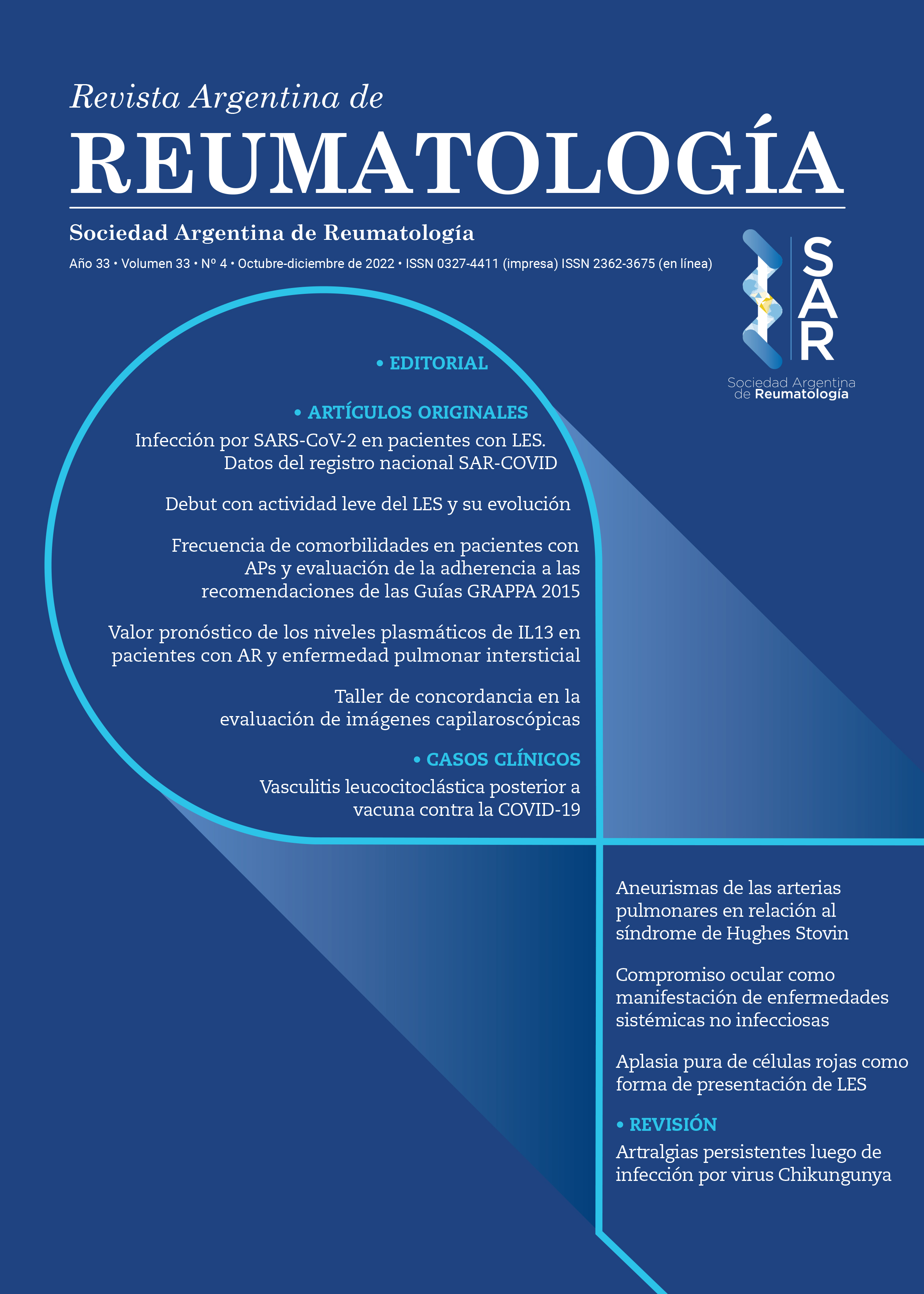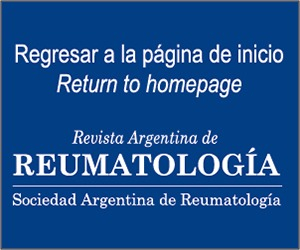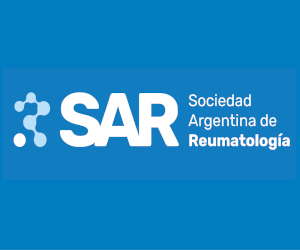Frequency of comorbidities in patients with psoriatic arthritis and evaluation of the adherence of physicians to the treatment recommendations of the GRAPPA 2015 Guidelines
Abstract
Introduction: comorbidities are common in patients with psoriatic arthritis (PsA). The GRAPPA (Group for Research and Assessment of Psoriasis and Psoriatic Arthritis) guidelines strengthen the choice of treatments according to them. Objectives: to describe the prevalence of comorbidities in patients with psoriatic arthritis according to Rheumatic Disease Comorbidity Index (RDCI) and to analyze the influence of them on disease activity, functional capacity and quality life and to assess adherence to GRAPPA 2015 treatment recommendations according to the presence of comorbidities. Materials and methods: cross-sectional study. Adult patients with PsA (CASPAR criteria) from the RAPSODIA cohort were included. Sociodemographic and clinical characteristics, disease activity and current treatment were recorded. Comorbidities were assessed by the RDCI. Variables associated with RDCI≥1 were studied by multivariate analysis. Adherence to treatment recommendations in relation to the reported comorbidities was analyzed according to the 2015 GRAPPA guidelines. Results: a total of 170 patients were included. Patients with RDCI ≥1 were reported by 67.6%. These patients were older (57±13 years vs 48±13 years, p<0.0001), had a higher frequency of overweight or obesity (84.3% vs 67.3%, p=0.011), and had a poorer quality of life (PsAQoL 7.6±6.6 vs 5.2±6, p=0.025). The multivariate analysis showed an association between age and the use of NSAIDs with RDCI≥1. Contrary to GRAPPA recommendations, 70% of patients with heart disease were using NSAIDs. Moreover, about half of those with hepatic or kidney disease took NSAIDs or methotrexate. Conclusions: most patients with PsA presented at least one comorbidity. GRAPPA recommendations were not followed in a considerable number of patients.References
I. Lacaille D, Avina-Zubieta JA, Sayre EC, Abrahamowicz M. Improvement in 5-year mortality in incident rheumatoid arthritis compared with the general population-closing the mortality gap. Ann Rheum Dis 2017;76(6):1057-63.
II. Haddad A, Saliba W, Lavi I, Batheesh A, Kasem S, Gazitt T, et al. The association of psoriatic arthritis with all-cause mortality and leading causes of death in psoriatic arthritis. J Rheumatol 2022;49(2):165.170. doi: 10.3899/jrheum.210159.
III. Ogdie A, Haynes K, Troxel AB, Love TJ, Hennessy S, Choi H, et al. Risk of mortality in patients with psoriatic arthritis, rheumatoid arthritis and psoriasis: a longitudinal cohort study. Ann Rheum Dis 2014;73(1):149-53.
IV. Elalouf O, Muntyanu A, Polachek A, Pereira D, Ye JY, Lee KA, et al. Mortality in psoriatic arthritis: Risk, causes of death, predictors for death. Semin Arthritis Rheum 2020;50(4):571-5.
V. Kaine J, Song X, Kim G, Hur P, Palmer JB. Higher incidence rates of comorbidities in patients with psoriatic arthritis compared with the general population using U.S. administrative claims data. J Manag Care Spec Pharm 2019;25(1):122-32.
VI. Horreau C, Pouplard C, Brenaut E, Barnetche T, Misery L, Cribier B, et al. Cardiovascular morbidity and mortality in psoriasis and psoriatic arthritis: a systematic literature review. J Eur Acad Dermatol Venereol 2013;27(3):12-29.
VII. González MC, Carrillo I, Cerda O, Landi M, Maldonado Ficco H, Maldonado-Cocco JA, et al. Comorbilidades en artritis psoriática y su impacto en la actividad de la enfermedad, capacidad funcional y calidad de vida. Rev Arg Reumatol 2013;27(8):72.
VIII. Fortin M, Hudon C, Dubois MF, Almirall J, Lapointe L, Soubhi H. Comparative assessment of three different indices of multimorbidity for studies on health-related quality of life. Health Qual Life Outcomes 2005;3(74):1-7.
IX. Rupp I, Boshuizen HC, Jacobi CE, Dinant HJ, van den Bos G. Comorbidity in patients with rheumatoid arthritis. Effect on health-related quality of life. J Rheumatol 2004;31(7):58-65.
X. Charlson ME, Pompei P, Ales KL, MacKenzie CR. A new method of classifying prognostic comorbidity in longitudinal studies. Development and validation. J Chronic Dis 1987;40(8):373-83.
XI. Elixhauser A, Steiner C, Harris DR, Coffey RM. Comorbidity measures for use with administrative data. Med Care 1998;36(8):8-27.
XII. England BR, Sayles H, Mikuls TR, Johnson DS, Michaud K. Validation of the rheumatic disease comorbidity index. Arthritis Care Res 2015;67(6):865-72.
XIII. Michaud K, Wolfe F. Comorbidities in rheumatoid arthritis. Best Pract Res Clin Rheumatol 2007;21(5):885-906.
XIV. Stouten V, Pazmino S, Verschueren P, Mamouris P, Westhovens R, de Vlam K, et al. RMD Open 2021;7(2):e001671.
XV. Coates LC, Kavanaugh A, Mease PJ, Soriano ER, Acosta-Felquer L, Armstrong AW, et al. Group for Research and Assessment of Psoriasis and Psoriatic Arthritis 2015 Treatment Recommendations for Psoriatic Arthritis. Arthritis Rheumatol 2016;68(5):1060-71.
XVI. Taylor W, Gladman D, Helliwell P, Marchesoni A, Mease P, Mielants H. Classification criteria for psoriatic arthritis: development of new criteria from a large international study. Arthritis Rheum 2006;54(8):2665-73.
XVII. Heuft-Dorenbosch L, Spoorenberg A, van Tubergen A, Landewé, Tempel H. Assessment of enthesitis in ankylosing spondylitis. Annals of the Rheumatic Diseases. 2003;62(5):127-32.
XVIII. Wallace AB. The exposure treatment of burns. Lancet 1951;3(4):501-4.
XIX. Sobolewski P, Walecka I, Dopytalska K. Nail involvement in psoriatic arthritis. Reumatol 2017; 55(3):131-5.
XX. Klassen KM, van de Kerkhof PC, Bastiaens MT, Plusjé LG, Baran RL, Pasch MCJ. Scoring nail psoriasis. Am Acad Dermatol 2014;70(6):1061-6.
XXI. Esteve J, Batlle E, Reig A . Spanish version of the Health Assessment Questionnaire: reliability, validity and transcultural equivalency. Grupo para la adaptación del HAQ a la población española. J Rheumatol 1993;20(12):2116-22.
XXII. Citera G, Arriola MS, Maldonado-Cocco J, Rosemffet M, Sánchez M, Goñi M, et al. Validation and crosscultural adaptation of an Argentine spanish version of the health assessment questionnaire disability index. J Clin Rheumatol 2004;10(3):110-5.
XXIII. McKenna SP, Doward LC, Whalley D, Tennant A, Emery P, Veale P. Development of the PsAQoL: a quality of life instrument specific to psoriatic arthritis. Annals of the Rheumatic Diseases 2004;63(2):162-69.
XXIV. Finlay A, Khan G. Dermatology Life Quality Index (DLQI): a simple practical measure for routine clinical use. Clin Exp Dermatol 1994; 19(3):210-16.
XXV. Schoels M, Aletaha D, Funovits J, Kavanaugh A, Baker D, Smolen J. Application of the DAREA/DAPSA score for assessment of disease activity in psoriatic arthritis. Ann Rheum Dis 2010;69(8):1441-7.
XXVI. Coronel-Ale AL, Schneeberger EE, Cerda OL, Zaffarana CF, MN, Landi M, et al. Disease Activity in Psoriatic Arthritis-ESR Index maybe a valid tool to evaluate disease activity in patients with psoriatic arthritis when CRP is not available. Arthritis Rheumatol 2017;69(10):2554.
XXVII. Coates L, Helliwell P. Validation of minimal disease activity criteria for psoriatic arthritis using interventional trial data. Arthritis Care Res 2010;62(7):965-9.
XXVIII. Iannone F, Salaffi F, Fornaro M, Di Carlo M, Gentileschi S, Cantarini L, Lopalco G. Influence of baseline modified Rheumatic Disease Comorbidity Index (mRDCI) on drug survival and effectiveness of biological treatment in patients affected with Rheumatoid arthritis, Spondyloarthritis and Psoriatic arthritis in real-world settings. Eur J Clin Invest 2018;48(11):e13013.
XXIX. Batko B, Urbański K, Świerkot J, Wiland P, Raciborski F, Jędrzejewski M, et al. Comorbidity burden and clinical characteristics of patients with difficult-to-control rheumatoid arthritis. Clin Rheumatol 2019;38(9):2473-81.
XXX. Bavière W, Deprez X, Houvenagel E, Philippe P, Deken V, Flipo RM, et al. Association between comorbidities and quality of life in psoriatic arthritis. Results from a multicentric cross-sectional Study. J Rheumatol 2020;47(3):369-76.
XXXI. Bhole VM, Choi HK, Burns LC, Vera Kellet C, Lacaille DV, Gladman DD, et al. Differences in body mass index among individuals with PsA, psoriasis, RA and the general population. Rheumatology (Oxford) 2012;51(3):552-6.
XXXII. Spaetgens B, Wijnands JM, van Durme C, Boonen A. Content and construct validity of the Rheumatic Diseases Comorbidity Index in patients with gout. Rheumatology (Oxford) 2015 Sep;54(9):1659-63.
XXXIII. Ogdie A, Yu Y, Haynes K, Love TJ, Maliha S, Jiang Y, et al. Risk of major cardiovascular events in patients with psoriatic arthritis, psoriasis and rheumatoid arthritis: a population-based cohort study. Ann Rheum Dis 2015;74(2):326-32.
XXXIV. Gossec L, Baraliakos X, Kerschbaumer A, de Wit M, McInnes I, Dougados M, et al. EULAR recommendations for the management of psoriatic arthritis with pharmacological therapies: 2019 update. Ann Rheum Dis 2020;79(6):700-12.
XXXV. Li L, Hagberg KW, Peng M, Shah K, Paris M, Jick S. Rates of cardiovascular dsease and major adverse cardiovascular events in patients with psoriatic arthritis compared to patients without psoriatic arthritis. J Clin Rheumatol 2015;21(8):405-10.
Copyright (c) 2022 Intellectual property rights: authors. Reproduction rights: Argentine Society of Rheumatology

This work is licensed under a Creative Commons Attribution-NonCommercial-NoDerivatives 4.0 International License.










